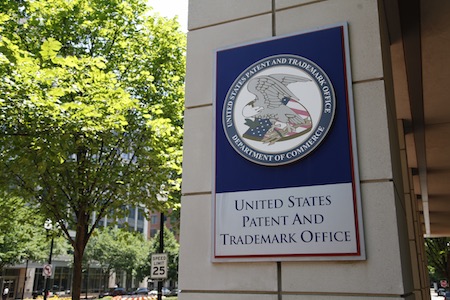“The provisions [were] revised “to specify a period of reduction corresponding to ‘the period from the beginning to the end of the applicant’s failure to engage in reasonable efforts to conclude prosecution’ (rather than corresponding to the consequences to the USPTO of the applicant’s failure to engage in reasonable efforts to conclude prosecution) for consistency with the Federal Circuit’s decision in Supernus.”
 On June 16, the USPTO published a final rule in the Federal Register revising the rules of practice regarding patent term adjustments in light of the U.S. Court of Appeals for the Federal Circuit’s (CAFC) 2019 decision in Supernus Pharmaceuticals v. Iancu, which held that reductions to patent term adjustments must be equal to the time in which the applicant failed to make reasonable efforts to conclude processing or examination of an application.
On June 16, the USPTO published a final rule in the Federal Register revising the rules of practice regarding patent term adjustments in light of the U.S. Court of Appeals for the Federal Circuit’s (CAFC) 2019 decision in Supernus Pharmaceuticals v. Iancu, which held that reductions to patent term adjustments must be equal to the time in which the applicant failed to make reasonable efforts to conclude processing or examination of an application.
Provisions on Patent Term Adjustment
Under the patent term adjustment provisions of 35 U.S.C. 154(b), as amended by the American Inventors Protection Act of 1999 (AIPA), an applicant may be entitled to a patent term adjustment of the typical 20 years from the filing date of the application for several reasons including: “(1) If the USPTO fails to take certain actions during the examination and issue process within specified time frames …; (2) if the USPTO fails to issue a patent within three years of the actual filing date of the application …; and (3) for delays due to interference (and now derivation), secrecy order, or successful appellate review.”
The AIPA sets forth several limitations on any patent term adjustment accrued under 35 U.S.C. 154(b)(1). For example, under 35 U.S.C. 154(b)(2)(C), the patent term adjustment “shall be reduced by a period equal to the period of time during which the applicant failed to engage in reasonable efforts to conclude prosecution of the application’. The regulations establishing what constitutes “a failure of an applicant to engage in reasonable efforts to conclude processing or examination of an application” are set forth in 37 CFR 1.704.
The Supernus Decision
In January 2019, the Federal Circuit issued a decision relating to patent term adjustment provisions of 35 U.S.C. 154(b)(2)(C) in Supernus. In particular, the Federal Circuit held that the patent term adjustment statue should be interpreted to include “not only applicant conduct or behavior that result in actual delay, but also those having the potential to result in delay irrespective of whether such delay actually occurred.” However, the Federal Circuit also noted that the USPTO may not reduce a patent term adjustment based on applicant delay “during a period of time … which there was no action [or identifiable effort] that the applicant could take to conclude prosecution of the patent.’’
Amendments to Title 37
In general, the final rule set forth in the June 16 Notice revised the period of reduction of patent term adjustment in the provisions of 37 CFR 1.704. The particular revised sections were:
(1) deferral of issuance of a patent (37 CFR 1.704(c)(2)),
(2) abandonment of an application (37 CFR 1.704(c)(3)),
(3) submission of a preliminary amendment (37 CFR 1.704(c)(6)),
(4) submission of papers after a decision by the Patent Trial and Appeal Board or by a Federal court (37 CFR 1.704(c)(9)), and
(5) submission of papers after a notice of allowance under 35 U.S.C. 151 (37 CFR 1.704(c)(10)).
Each of the provisions was revised “to specify a period of reduction corresponding to ‘the period from the beginning to the end of the applicant’s failure to engage in reasonable efforts to conclude prosecution’ (rather than corresponding to the consequences to the USPTO of the applicant’s failure to engage in reasonable efforts to conclude prosecution) for consistency with the Federal Circuit’s decision in Supernus.” In addition, 37 CFR 1.704(c)(10) has been revised to exclude “after-allowance amendments or other after-allowance papers that are ‘expressly requested by the Office’’’ from the reduction of patent term adjustment.
The changes to the AIPA patent term adjustment provisions apply to all applications and patents eligible for patent term adjustment wherein a notice of allowance was mailed on or after July 16, 2020 and the adjustment determinations are made by a computer program that uses information recorded in the USPTO’s Patent Application Locating and Monitoring (PALM) system.

![[IPWatchdog Logo]](https://ipwatchdog.com/wp-content/themes/IPWatchdog%20-%202023/assets/images/temp/logo-small@2x.png)

![[[Advertisement]]](https://ipwatchdog.com/wp-content/uploads/2024/04/Patent-Litigation-2024-banner-938x313-1.jpeg)
![[Advertisement]](https://ipwatchdog.com/wp-content/uploads/2024/04/UnitedLex-May-2-2024-sidebar-700x500-1.jpg)
![[Advertisement]](https://ipwatchdog.com/wp-content/uploads/2024/04/Artificial-Intelligence-2024-REPLAY-sidebar-700x500-corrected.jpg)
![[Advertisement]](https://ipwatchdog.com/wp-content/uploads/2024/04/Patent-Litigation-Masters-2024-sidebar-700x500-1.jpg)

![[Advertisement]](https://ipwatchdog.com/wp-content/uploads/2021/12/WEBINAR-336-x-280-px.png)
![[Advertisement]](https://ipwatchdog.com/wp-content/uploads/2021/12/2021-Patent-Practice-on-Demand-recorded-Feb-2021-336-x-280.jpg)
![[Advertisement]](https://ipwatchdog.com/wp-content/uploads/2021/12/Ad-4-The-Invent-Patent-System™.png)






Join the Discussion
One comment so far.
Diana Callen
June 26, 2020 02:04 amThis may or may not have anything to do with this subject,regardless I want to be heard .I came up with a product in 2017 that would of help to save life’s in this pandemic but unfortunately I was scammed out of over 18,000 $ by a company called ;patent sevice USA who did file a patent application and I do have a utility patent pending of a BOXS which is not my invention.I would truly appreciate some help with this fraud .Thank you for your time Sencerly .